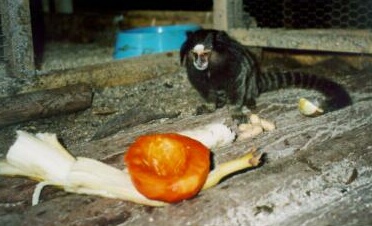|
|
|
|

|
|
|
|
 |

forest in the Farm and have a 'treat' sometimes on a plataform in their "territory" |
|
The
Black-pencilled Marmoset
(Callithrix penicillata)
also known as the
Black-tufted Marmoset and Mico-estrela in
Portuguese, is a species of New World monkey that lives primarily in
the Neo-tropical gallery forests of the Brazilian Central
Plateau. It
ranges from Bahia to Paraná and as far inland as Goiás,
between 14 and
25 degrees south of the equator. This marmoset typically resides in
rainforests, living an arboreal life high in the trees, but below the
canopy. They are only rarely spotted near the ground.. . Behavior
Diurnal and arboreal, the
Black-pencilled Marmoset has a lifestyle very
similar to other marmosets. It typically lives in family groups of 2 to
14. The groups usually consist of a reproductive couple and their
offspring. Twins are very common among this species and the males, as
well as juvenile offspring, often assist the female in the raising of
the young.. Though the Black-pencilled Marmoset lives in small family groups, it is believed that they share their food source, sap trees, with other marmoset groups. Scent marking does occur within these groups, but it is believed that the marking is to deter other species rather than other Black-pencilled Marmoset groups, because other groups typically ignore these markings. They also appear to be migratory, often moving in relation to the wet or dry seasons, however, the extent of their migration is unknown. .
.
Though communication between
Black-pencilled Marmosets has not been
studied thoroughly, it is believed that it communicates through
vocalizations. It has known predator-specific cries and appears to
vocalize frequently outside of predator cries.. The Black-pencilled Marmoset diet consists primarily of tree sap which it gets by nibbling the bark with its long lower incisors. In periods of drought, it will also include fruit and insects in its diet. In periods of serious drought it has also been known to eat small arthropods, molluscs, bird eggs, baby birds and small vertebrates. . Large birds of prey are the greatest threat to the Black-pencilled Marmoset, however, snakes and wild cats also pose a danger to them. Predator-specific vocalizations and visual scanning are its only anti-predation techniques. . Reproduction
The Black-pencilled Marmoset
is monogamous and lives in family groups.
It reproduces twice a year, producing 1 to 4 offspring, though they
most often just twins. Its gestation period is 150 days and offspring
are weaned after 8 weeks. There is considerable parental investment by
this species, with both parents, as well as older juveniles, helping to
raise the young. The offspring are extremely dependent on their parents
and though they are sexually mature at 18 months, they typically do not
mate until much later, staying with their family group until they do. |